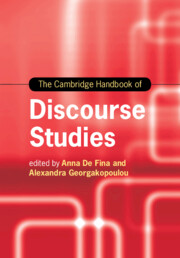Book contents
- The Cambridge Handbook of Discourse Studies
- Cambridge Handbooks in Language and Linguistics
- The Cambridge Handbook of Discourse Studies
- Copyright page
- Contents
- Figures
- Tables
- Contributors
- Preface
- Part I (Con)Textualizing Discourses
- 1 Registers, Styles, Indexicality
- 2 Situating Discourse Analysis in Ethnographic and Sociopolitical Context
- 3 Context and Its Complications
- 4 Historicity, Interdiscursivity and Intertextuality in Discourse Studies
- 5 Rethinking Narrative: Tellers, Tales and Identities in Contemporary Worlds
- Part II Perspectives and Modes of Analysis
- Part III Discourse Materialities and Embodiment
- Part IV (Trans)Locations and Intersections
- Part V Ethics, Inequality and Inclusion
- Part VI Discourses, Publics and Mediatization
- Index
- References
3 - Context and Its Complications
from Part I - (Con)Textualizing Discourses
Published online by Cambridge University Press: 28 September 2020
- The Cambridge Handbook of Discourse Studies
- Cambridge Handbooks in Language and Linguistics
- The Cambridge Handbook of Discourse Studies
- Copyright page
- Contents
- Figures
- Tables
- Contributors
- Preface
- Part I (Con)Textualizing Discourses
- 1 Registers, Styles, Indexicality
- 2 Situating Discourse Analysis in Ethnographic and Sociopolitical Context
- 3 Context and Its Complications
- 4 Historicity, Interdiscursivity and Intertextuality in Discourse Studies
- 5 Rethinking Narrative: Tellers, Tales and Identities in Contemporary Worlds
- Part II Perspectives and Modes of Analysis
- Part III Discourse Materialities and Embodiment
- Part IV (Trans)Locations and Intersections
- Part V Ethics, Inequality and Inclusion
- Part VI Discourses, Publics and Mediatization
- Index
- References
Summary
The widespread incorporation of online communicative practices in the repertoires of language users has profoundly affected the structure of communicative ecologies around the world, thus compelling us to adjust some of our core vocabulary accordingly. This chapter therefore critically reexamines one of the key notions in discourse studies: context. Treating context as inextricably connected with meaning-making has historically set discourse studies apart from more formal branches in the study of language. This, however, has not necessarily led to overly sophisticated notions of context, and the mainstream modes of usage of context in much discourse analysis can be characterized as vague and imprecise, grounded in and biased by a default image of spoken, dyadic offline (“local”) discourse events as the most natural and fundamental ones. Such views of context have been imported in studies of online communication, leading to highly questionable but influential insights such as those on “context collapse.” In this chapter, I review some of the conceptual problems related to context in online–offline communicative ecologies. I argue that, in order to avoid the bias described earlier (spoken, dyadic and offline discourse as the “zero point” of language use), we might wish to shift to taking communicative action as our unit of analysis, and address this unit in its fullest ethnographic sense as characterized by normatively circumscribed sets of resources and participants brought into specific time-space constellations enabling and constraining the deployment and uptake of specific lines of activity, leading to effects that are effects both of meaning and of moral and identity valuations. Actions are here defined as chronotopically organized and ordered, with on- and offline chronotopes having particular characteristics and interactions between such chronotopically described “contexts” involving complex shifts in resource valuation, participation frameworks and normative codes of conduct, previously described as shifts in footing. Taking this approach, I argue, enables us to avoid the spoken-dyadic-offline bias inscribed in mainstream notions of context, forcing the analyst not just to approach new online forms of interaction as “abnormal” or “exceptional” interactions, even if they are characterized by the deployment of written/designed resources and directed at “networked publics” rather than at the individual interlocutor of dyadic interaction, and even if they appear not to respect clear boundaries between the online and the offline world. The chronotopic character of contexts for communicative action enables, I suggest, a new imagination of “society” as the necessary backdrop for any consideration of discourse, its means and effects, and in that sense invites a broad range of alternative theoretical and descriptive revisions.
Keywords
- Type
- Chapter
- Information
- The Cambridge Handbook of Discourse Studies , pp. 52 - 69Publisher: Cambridge University PressPrint publication year: 2020
References
Further Reading
References
- 7
- Cited by



